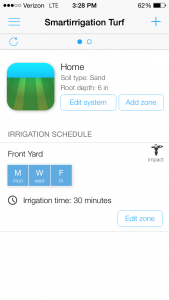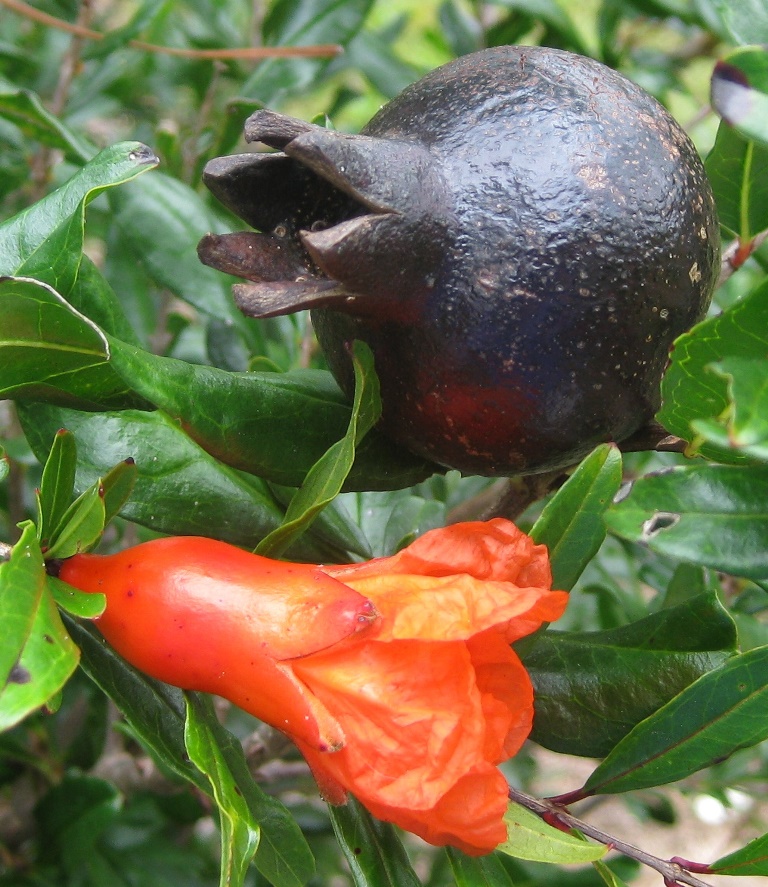
by Gary Knox | Jun 17, 2014
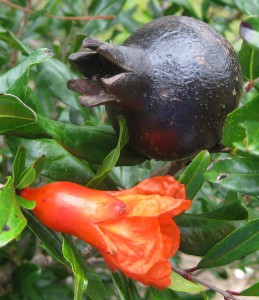
Orange flowers and purple fruits often occur on Purple Sunset pomegranate at the same time, producing a colorful display. Photo by Gary Know, UF IFAS.
Purple Sunset is a new ornamental cultivar of pomegranate, Punica granatum. Purple Sunset pomegranate is distinguished from fruiting pomegranate by a bushy, compact habit and numerous flowers followed by small, ornamental, purple-black fruit.
Native to southeastern Europe and Asia, pomegranate has long been grown for its edible fruits. Horticulturists recently recognized its ornamental qualities and began selecting pomegranate for form, flowering, and ornamental fruits. ‘PIIPG-1’ is a cultivar selected from open-pollinated seeds of Punica granatum ‘Nana’. Trademarked as Purple Sunset, this cultivar has a bushy, compact growth habit. Although promoted as a dwarf form that grows only 3–4 feet, plants in north Florida (USDA Cold Hardiness Zone 8b) have grown significantly larger, approaching 6 feet in height 3 years after planting. Purple Sunset pomegranate may be used in the landscape as a specimen plant or hedge.
Leaves of new growth are red-tinged, becoming glossy green throughout summer, and turning yellow to yellow-green in late fall before dropping in early winter. Large two-inch orange flowers occur on new growth throughout summer and fall. The orange flowers develop into inedible, shiny, purple-black fruit up to three inches in diameter. Orange flowers and purple fruits often occur on the plant at the same time, producing a colorful display. Fruits persist into winter, adding interest to the leafless shrub, before eventually falling. Wildlife may eat the tough, seedy fruits, but this has not been documented.
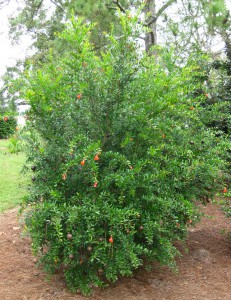
Purple Sunset pomegranate in North Florida. Photo by Gary Knox, UF IFAS.
Culture of Purple Sunset pomegranate is similar to fruiting pomegranate. This plant is hardy in USDA Cold Hardiness Zones 7–10. It grows best in full sun to part shade on deep, loamy soils but is adapted to all but alkaline soils. Pomegranate is somewhat drought tolerant once established. Hedged plants should be pruned in late winter before new spring growth. Leaf spot and fruit blotch, diseases of fruiting pomegranate, may also affect Purple Sunset, but these problems have not been noted in the landscape.
For more information:
The Pomegranate
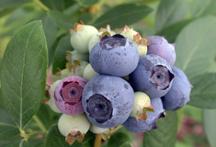
by Roy Carter | Jun 10, 2014

Blueberry. Photo credit: Eric Zamora, UF IFAS.
Blueberries are native to Eastern North America. They are one of the few crop plants that originated here. The rabbiteye blueberry occurs mostly in certain river valleys in Northern Florida and Southeastern Georgia. The high bush blueberry is native to the eastern third of the United States and Southeastern Canada. Florida is rich in other native species. The woods and swamps of Florida are populated with at least eight wild blueberry species. No area of the state lacks wild blueberries, except where soil pH is above 6.0.
The two types of blueberries grown in Florida are Southern highbush and rabbiteye. The earliest ripening southern highbush varieties ripen about 4 to 6 weeks earlier than the earliest rabbiteye varieties grown at the same location.
Some rabbiteye varieties recommended for our area are: Alice blue, Beckyblue, Climax, Bonita, Brightwell, Chaucer and Tifblue. Some recommended Southern Highbush varieties are: Blue Crisp, Gulf Coast, Jewel, Sharpblue, Santa Fe, Star and Misty.
Blueberries need a fairly acid soil; a pH range of 4 to 5 is suggested. Blueberries grown on alkaline or deep sands will grow poorly. If you need to lower the soil pH before planting, mix in some acidic peat moss.
Blueberries have a shallow, fibrous root system. That means plants should be placed in the ground about an inch deeper than they were growing in the nursery. Rabbiteye blueberries grow poorly in soils with excessive drainage. But they won’t tolerate too much moisture for long periods of time either.
Blueberries are very sensitive to fertilizers. During the first growing season, no mineral fertilizer should be added at all. In the second season, apply about two ounces of an acidic fertilizer per plant. Blueberries can use the same fertilizer as camellias and azaleas, but be careful not to overdo it. Excessive amounts of fertilizer will kill the plants.
Before planting blueberries, you should cultivate the soil by plowing or roto tilling to a depth of at least six inches. Dig a hole large enough so that the roots won’t be crowded. Lightly pack the soil around the roots and water thoroughly. Keep in mind that newly set plants need a good water supply.
Bare-root bushes should be transplanted during the winter months; container grown bushes can be transplanted anytime. The first year after planting, the blossoms should be removed to help the bush grow more quickly.
Pruning is an important part of blueberry culture. It promotes the growth of strong wood, and rids the tree of weak twiggy growth. The strong wood growth is necessary for good fruit production.
Believe it or not, the worst pests of blueberries are birds. You need to protect your bushes with some kind of netting, or employ the old fashioned scarecrow to do the job. It you don’t protect your bushes, you can count on the birds getting to the fruit before you do.
Other than birds, rabbiteye blueberries have few pest or disease problems. Powdery mildew can occur on bushes that don’t get full sun, but this problem can be easily controlled with a sulfur spray. Bud mites, thrips, fruitworms, and defoliating insects can sometimes be a problem.
Weeds will compete with young blueberry bushes for nutrients and water, so keep the beds as free of weeds as possible. Mulches are good for controlling weed growth. If necessary, there are herbicides available.
For more information please see:
Blueberry Gardener’s Guide
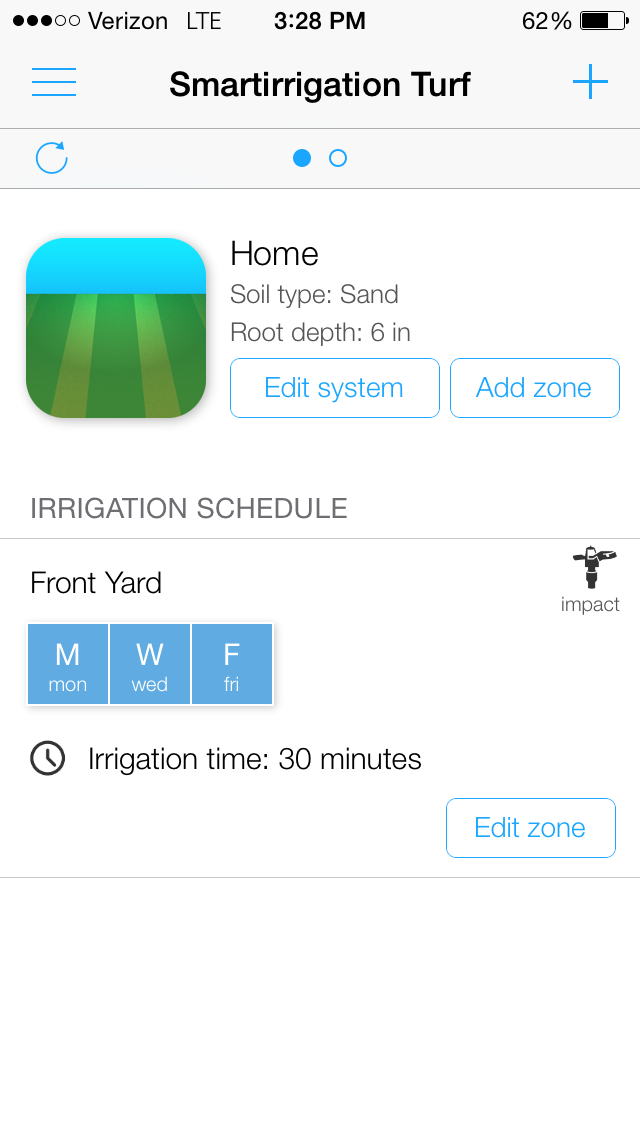
by Blake Thaxton | Jun 10, 2014
In this age of tablets, smart phones, and whatever they come up with next, even the gardener can benefit from new technology. Although gardening and landscaping to beautify our surroundings is a way to connect with the past, there are many new tools that are ready to help! Here are a few web sites and phone apps that may prove useful to the gardener.
Sod Solutions has made it easy to know how much sod you need to order by using a mapping system to create overlays that measure square footage. Measuring square footage can prove tough for irregularly shaped beds or turf lawns. This website can help measure accurately so one can also apply the correct amount of herbicides, pesticide, or fertilizer. The website can be difficult for the technology challenged among us. An easy solution is to find anyone under the age of 15 and they should be able to help!
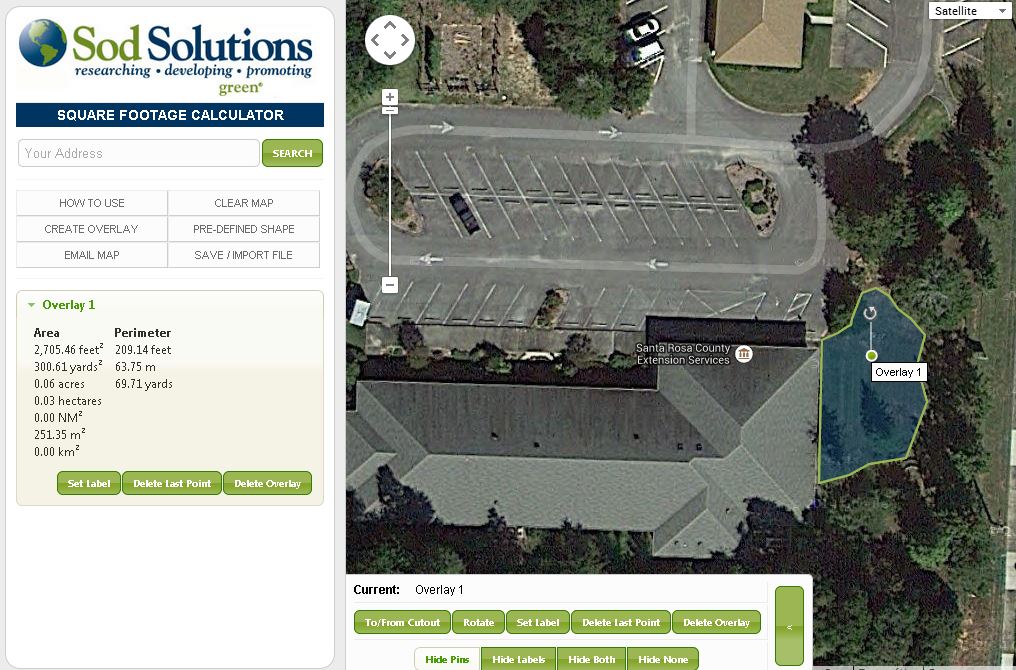
The Smartirrigation Turf app is designed to help homeowners with automatic irrigation systems in scheduling their watering times correctly. This app takes everything into account from soil type to local weather conditions. For example, you set a watering schedule for Zone X of 15 minutes every Monday, Wednesday, and Friday. Then, it does not rain for an extended period of time. Because your lawn does not get the supplemental rain that was predicted, the app may tell the home owner to change the setting to 25 minutes. To read more about using the app correctly, click on the link above.
Other apps that might prove useful are:
- NCSU Lawn Care App – An App by North Carolina State University all about lawn care.
- SoilWeb for Iphone – Produced by The California Soil Resource Lab that will tell you what kind of soil you are standing on.
- Leaf Snap – Developed by Columbia University, University of Maryland, and Smithonian Institution. The app uses visual recognition software to identify plants by taking pictures of its leaves.
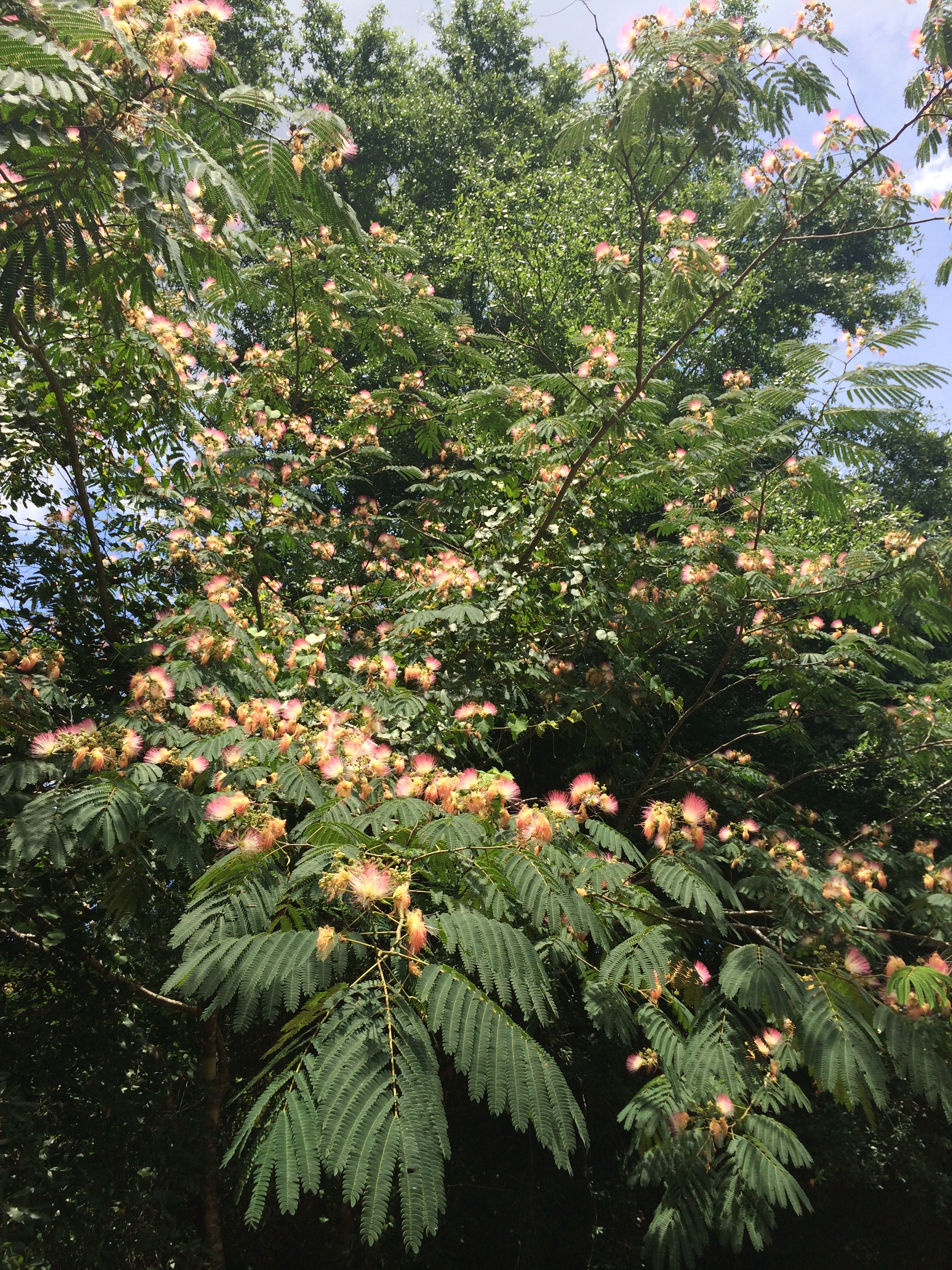
by Mary Salinas | Jun 10, 2014
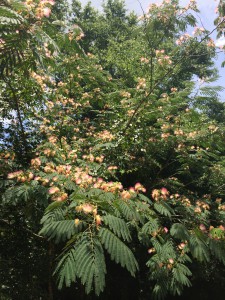
A mimosa tree invader in a natural area. Photo by Mary Derrick, UF IFAS.
All along the roadsides and in home landscapes this time of year, a profusion of fluffy pink blossoms are adorning trees known as Mimosa, or Albizia julibrissin. This native of China was introduced to home landscapes in this country in the 1700’s to enjoy the fragrant, showy flowers and fine, lacy foliage. However, there is a dark side to this lovely tree. After blooming, it produces an abundance of pods each containing 5 to 10 seeds. Seeds can be spread by wildlife and water; this is evidenced by the appearance of mimosa trees along the roadways, streams and in our natural areas. The seeds can also remain dormant for many years, allowing seedlings to keep sprouting up long after the mother tree is gone.
Mimosa has been categorized as an invasive exotic plant in Florida as it has not only naturalized, but is expanding on its own in Florida native plant communities. This expansion means that our native plants in natural areas get crowded out by the mimosa as it reproduces so prolifically.
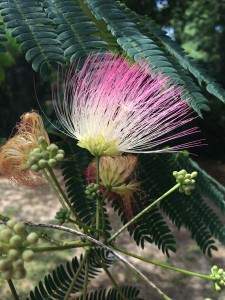
Bloom and foliage of the invasive mimosa tree. Photo by Mary Derrick, UF IFAS.
[important]The Florida Exotic Pest Plant Council (FLEPPC) publishes a list of non-native plants that have been determined to be invasive. Click here for the most recent 2013 list![/important]
The first step in controlling this pest plant is to remove existing plants in the landscape. Cutting it down at soil level and immediately painting the stump with a 25% solution of glyphosate or triclopyr should do the trick. Other details and control methods can be found here.
There are some native trees that make excellent alternatives to Mimosa such as fringe tree (Chionanthus virginicus), silverbell (Halesia carolina) and flowering dogwood (Cornus florida).
For more information:
Albizia julibrissin: Mimosa
UF IFAS Center for Aquatic and Invasive Plants: Mimosa
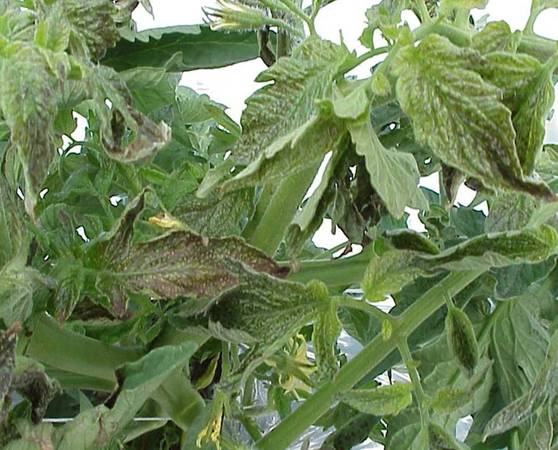
by Eddie Powell | Jun 3, 2014
During this growing season monitor your plants and keep them healthy as a healthy plant will be able to better survive an invader attack.
Nematode populations can be reduced temporarily by soil solarization. It is a technique that uses the sun’s heat to kill the soil-borne pests. Adding organic matter to the soil will help reduce nematode populations as well. Nematodes are microscopic worms that attack vegetable roots and reduce growth and yield. The organic matter will also improve water holding capacity and increase nutrient content.
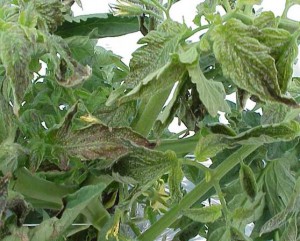
Tomato Spotted Wilt Virus
Credits: UF/IFAS
If you choose to use pesticides, please follow pesticide label directions carefully. Learn to properly identify garden pests and use chemicals only when a serious pest problem exists. If you have questions please call your UF/IFAS county extension office. We can provide helpful information about insect identification.
Organic gardeners can use certain products like BT(Dipel) to control pests. Please remember not every off-the-shelf pesticide can be used on every crop. So be sure the vegetable you want to treat is on the label before purchasing the product.
Follow label directions for measuring, mixing and pay attention to any pre-harvest interval warning. That is the time that must elapse between application of the pesticide and harvest. For example, broccoli sprayed with carbaryl (Sevin) should not be harvested for two weeks.
Spray the plant thoroughly, covering both the upper and lower leaf surfaces. Do not apply pesticides on windy days. Follow all safety precautions on the label, keep others and pets out of the area until sprays have dried. Apply insecticides late in the afternoon or in the early evening when bees and other pollinators are less active. Products like malathion, carbaryl and pyrethroids are especially harmful to bees.
To reduce spray burn, make sure the plants are not under moisture stress. Water if necessary and let leaves dry before spraying. Avoid using soaps and oils when the weather is very hot, because this can cause leaf burn.
Control slugs with products containing iron phosphate.
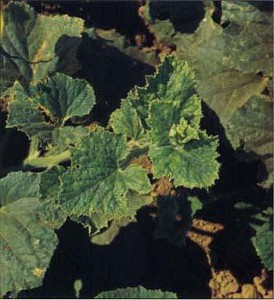
Cucumber Mosaic Virus
Credits: UF/IFAS
Many common diseases can be controlled with sprays like chlorothalonil, maneb, or mancozeb fungicide. Powdery mildews can be controlled with triadimefon, myclobutanil, sulfur, or horticultural oils. Rust can be controlled with sulfur, propiconazole, ortebuconazole. Sprays are generally more effective than dusts.

by Taylor Vandiver | Jun 3, 2014
In a world of limited time and space, container gardens seem to make more and more sense. Poor soil and no place to put plants in the ground are no longer good excuses for not being able to enjoy the simple pleasures of gardening. Container gardening allows the individual to create gardens to fit any situation. Gardening in containers can be just as rewarding as having a full-size garden.
There are a few items to consider when you are planning your container garden. The first is the plants you intend to use. If you are planting more than one plant in the same pot be sure that all your plants meet the same requirements. The requirements you should consider are amount of light, amount of water, climate and fertilizing needs. Some other things you might want to think about when planning your container garden are height, color, and texture. A nice variation of these elements will make your container gardens more attractive and increasingly more interesting to look at.
The next step in container gardening is choosing your container. A good rule of thumb is: “Anything that holds soil and has drainage holes in the bottom may be transformed into a container garden.” It can be a pot you purchased from the local gardening center or an old bathtub you picked up off the side of the road. However, be sure that the size of the container matches the current and potential size of your plant. For vibrant plant growth, the containers must provide adequate space for roots and soil media, allowing the plant to thrive.
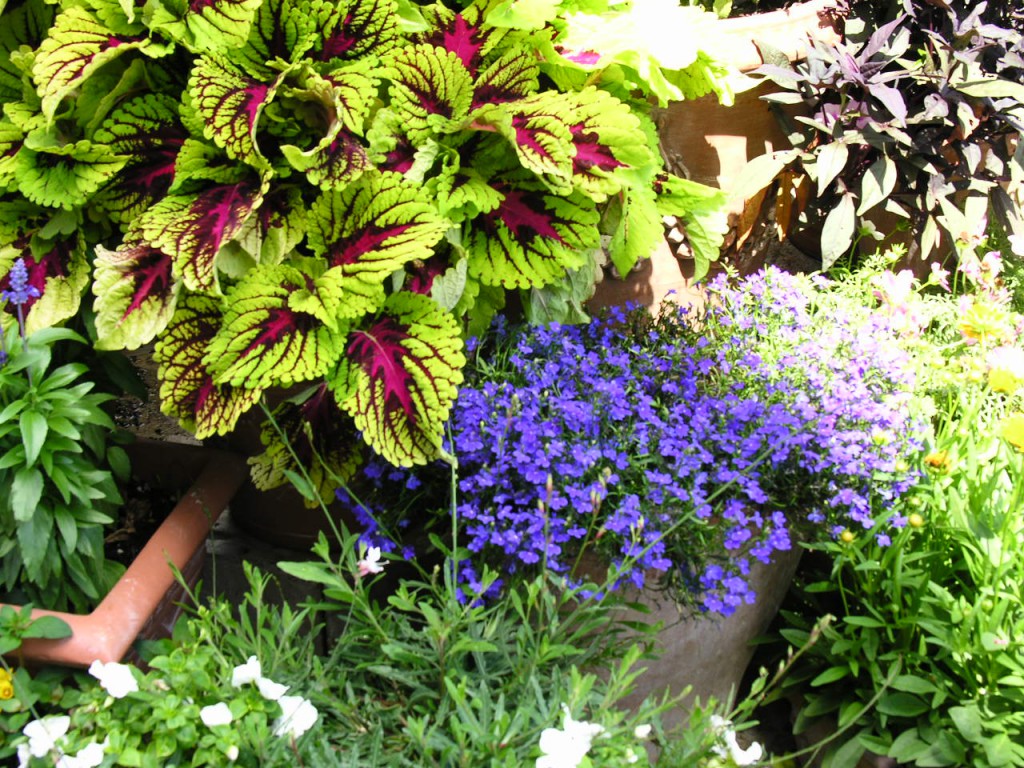
Colorful containers bring life to your small spaces.
Next on your list is choosing a soil for your container. Container soils need have good aeration and decent drainage, while still being able to retain enough moisture and nutrients for plant growth. When choosing what to use in containers, never use garden soil by itself. When garden soil is added to a container, both drainage and aeration are severely impeded, and the results are plants that grow poorly or not at all.
Container soils are often referred to as soilless or artificial media, because they literally contain no soil. They are commonly composed of various media such as peat moss, perlite, vermiculite, bark and coir fiber (ground coconut hulls) in a variety of mixes. When using soilless media remember t0 moisten it slightly before planting. Fill a tub with the media, add water and lightly fluff the media to dampen it. This will keep the mixture from becoming hydrophobic (unable to take up water) throughout its life in the container. When adding media to your containers, never fill the pot to the top. You should leave about a one-inch space between the top of the soil and rim of the pot. This will make watering the pot easier as it provides a place to “put water” and not have it run over the edge.
When watering your container gardens, the best time to do so is in the morning. Watering in the morning allows the leaves of your plants and soil to dry out, preventing diseases and viruses. Remember that overwatering is the most common reason for fatalities in container gardens. Check your soil by pushing your finger into the media; if the media is moist don’t water it. When it comes to fertilizing your container gardens, fertilize only as needed. Over-fertilization will result in a buildup of salts and may burn the roots of your plants. Try to fertilize your plants during the growing season, and only if needed during the dormant seasons.
The most important objective when container gardening is to be creative. Maybe, try a variety of plants in one container garden. While an nicely put together individual container can be quite impressive, think what might happen if you put several containers together in a group. Also, don’t limit your container gardens to flowers–many vegetables can be grown in a container and actually do quite well. There really is no limit to what can be done in a container!







